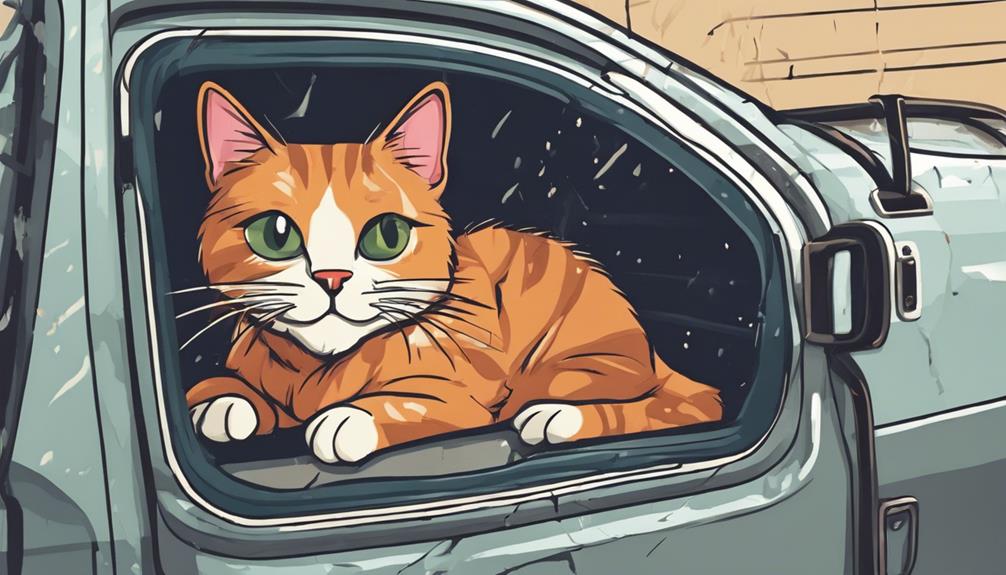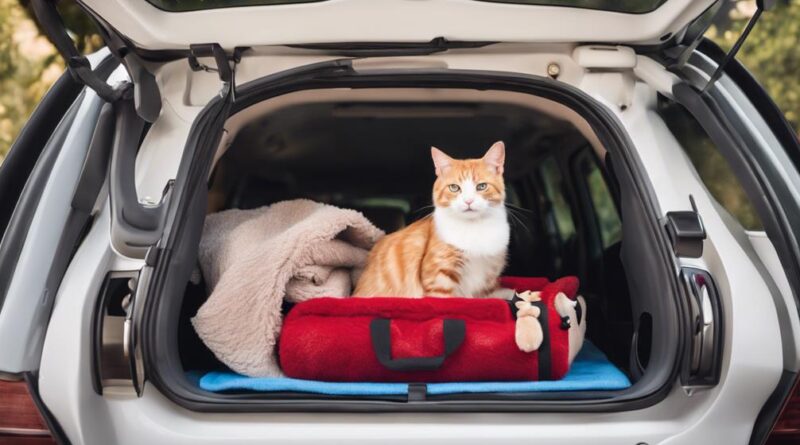What Are Essential Tips for Cat Car Journeys?
You might think that traveling with a cat in the car is a daunting task, but with the right preparation, it can be a smooth journey for both you and your feline companion.
Ensuring your cat's safety and comfort during car rides is crucial, but there are several essential tips that can help make the experience more manageable.
From proper restraint methods to handling your cat's anxiety, each step plays a vital role in creating a stress-free car journey for you and your furry friend.
Proper Restraint for Safety
When traveling with your cat in the car, ensure they're properly restrained to guarantee their safety. Using a seat belt specifically designed for cats or a secure carrier is crucial in preventing any accidents or injuries during the journey. Before starting the car, make sure your cat is comfortably settled in their carrier, allowing them to adjust and feel secure.
Seat belts aren't just for humans; there are specially made seat belt harnesses that can be used for cats. These harnesses are designed to keep your cat safe and secure in case of sudden stops or accidents. Make sure the harness fits properly and that your cat is comfortable wearing it before starting your journey.
Carrier training is essential for ensuring your cat remains calm and relaxed during car rides. Start by placing your cat's carrier in a familiar and comfortable area of your home. Encourage your cat to explore the carrier by leaving treats or toys inside. Gradually increase the time your cat spends inside the carrier until they're comfortable spending extended periods in it.
Familiarize Your Cat With the Car
To help your cat feel more comfortable during car journeys, start by gradually familiarizing them with the car environment. Positive reinforcement and gradual exposure are key to ensuring your cat associates the car with positive experiences. Here are some tips to make this process smoother:
- Start Slow: Begin by simply sitting with your cat in the car while it's parked. This helps them get used to the sounds and smells of the vehicle.
- Short Rides: Take short drives around the block to accustom your cat to the motion of the car. Use treats and praise to create a positive association.
- Increase Duration: As your cat becomes more comfortable, gradually increase the length of the car rides. Continue to reward good behavior.
- Create a Comfortable Space: Place familiar bedding or toys in the car to make it feel more like home for your cat. This can help reduce anxiety during the journey.
Pack Essentials for the Journey
Consider essential items to pack for your cat's journey to ensure their comfort and safety. Before hitting the road, make sure to pack emergency supplies such as a first aid kit for your cat, including any necessary medications, bandages, and antiseptic wipes in case of accidents or sudden health issues. It's also crucial to have your cat's medical records handy in case of emergencies.
Additionally, a sturdy and comfortable travel carrier is a must for transporting your cat securely. The carrier should be well-ventilated, spacious enough for your cat to stand and turn around, and secure enough to prevent any escapes during the journey. Familiarize your cat with the carrier beforehand by leaving it open in your home and placing treats or toys inside to create positive associations.
Ensure the carrier is lined with a soft blanket or towel for your cat's comfort during the journey. It's advisable to pack some of your cat's favorite toys, a familiar blanket or bed, and a small litter tray with some litter for longer journeys. Having these familiar items can help reduce your cat's stress and make them feel more at ease in unfamiliar surroundings.
Consider Your Cat's Comfort
For your cat's journey, ensuring their comfort is essential to minimize stress and keep them relaxed throughout the trip. Here are some tips to consider for your feline friend:
- Cozy Bedding: Providing your cat with familiar and comfortable bedding can help them feel secure during the journey. Make sure the bedding is soft and cozy to keep them relaxed.
- Favorite Toys: Bringing along your cat's favorite toys can help keep them entertained and distract them from the unfamiliar surroundings. Toys can also provide a sense of comfort and normalcy for your cat.
- Proper Ventilation: Ensuring good airflow in the car is crucial for your cat's comfort. Proper ventilation can help regulate the temperature and keep the air fresh, making the journey more pleasant for your cat.
- Avoid Loud Music: Cats are sensitive to loud noises, so it's best to keep the music volume low during the car journey. Opt for calming music or simply drive in silence to create a peaceful environment for your cat.
Plan for Breaks and Rest Stops
Planning regular breaks and rest stops along your cat's journey is crucial to ensure their well-being and comfort throughout the trip. Just like humans, cats need to stretch their legs and have potty breaks to stay comfortable during long car rides. When embarking on a road trip with your feline friend, remember to factor in these essential breaks.
During your journey, aim to stop every 2-3 hours to allow your cat to move around a bit and relieve themselves if needed. Find safe and quiet spots, away from traffic, to pull over and let your cat out of their carrier for stretch breaks. Use a harness and leash to ensure they don't wander off and stay close to supervise them.
For potty breaks, bring along a portable litter box and set it up in a secure area within your vehicle or outside if possible. Encourage your cat to use the litter box during these stops. It's important to maintain their usual routine as much as possible to reduce stress and keep them comfortable.
Manage Your Cat's Anxiety
To ensure a smooth journey for your cat, address any anxiety they may experience during car rides by creating a calming environment. Cats can often feel stressed in unfamiliar moving vehicles, so it's essential to take steps to keep them relaxed. Here are some tips to help manage your cat's anxiety:
- Calming techniques: Utilize calming aids such as pheromone sprays or diffusers designed specifically for cats. These can help create a soothing atmosphere in the car.
- Vet advice: Consult your veterinarian for advice on anti-anxiety medications or supplements that may help your cat stay calm during the journey.
- Behavior modification: Gradually acclimate your cat to car rides by starting with short trips and gradually increasing the duration. Pairing these rides with positive experiences can help modify their behavior.
- Stress relief: Provide your cat with familiar items like their favorite blanket or toy to help reduce stress and make them feel more comfortable during the journey.
Ensure Adequate Ventilation

Adequately ventilating the car is crucial to ensure your cat's comfort and well-being during car journeys. When positioning the ventilation, make sure that air can flow freely throughout the car, reaching your cat's designated area. Placing vents strategically to avoid direct airflow on your cat will prevent them from getting too cold. Additionally, maintaining these vents by regularly cleaning them will ensure that the air quality remains fresh and free of dust or debris that could irritate your cat's respiratory system.
Proper ventilation placement involves considering where your cat's carrier or seat is located in the car. If possible, aim to have vents that can be adjusted to direct airflow away from your cat while still providing adequate circulation. This way, your feline companion won't be subjected to drafts or stagnant air during the journey. Moreover, ensuring that the ventilation system in your car is functioning optimally will help regulate the temperature and keep the air inside the vehicle clean.
In terms of ventilation maintenance, periodically check and clean the vents to prevent any blockages that could hinder airflow. A simple wipe with a damp cloth or using a vacuum with a brush attachment can help remove any buildup of dust or dirt. By staying on top of ventilation maintenance, you can create a comfortable and healthy environment for your cat during car rides.
Be Prepared for Emergencies
Ensure your cat's safety by preparing for potential emergencies before embarking on car journeys. Being equipped and informed can make all the difference in handling unexpected situations.
- Emergency supplies: Pack a kit that includes essentials such as a first aid manual, gauze pads, adhesive tape, antiseptic wipes, and any medications your cat might need.
- Emergency vet contacts: Research and keep a list of emergency veterinary clinics along your route. Save their contact information in your phone and have a hard copy as a backup.
- Cat carrier: Always have a secure and well-ventilated carrier on hand for your cat. In case of an emergency, the carrier will provide a safe and familiar space for your cat.
- Temporary identification: Consider using a temporary ID tag on your cat's collar with your contact information and any relevant medical details. This can be crucial if you and your cat get separated during an emergency.
Frequently Asked Questions
Can I Give My Cat Medication to Help Them Relax During Car Journeys?
If you're considering giving your cat medication to help them relax during car journeys, think about natural remedies or alternatives first. Behavioral training and desensitization techniques can also be effective.
Consult with your vet before administering any medication to ensure it's safe for your cat. Remember, it's essential to prioritize your cat's well-being and comfort during car rides.
How Can I Prevent My Cat From Getting Car Sick?
To prevent your cat from getting car sick, try easing motion sickness with remedies like ginger or medications from the vet.
For anxiety, provide solutions such as using a comfortable carrier, covering it partially to create a calming space, and playing soothing music during the journey.
These steps can help make car rides less stressful for your feline friend.
Should I Feed My Cat Before a Car Journey or Wait Until We Arrive at Our Destination?
Before a car journey, it's best to stick to your cat's regular feeding schedule to prevent dehydration and anxiety.
Feeding your cat a small meal a few hours before the journey can help with motion sickness. Avoid feeding a big meal right before the trip to reduce the risk of car sickness.
Providing water and keeping a familiar blanket or toy in the carrier can also help keep your cat calm during the journey.
Is It Safe to Have My Cat Roam Freely in the Car While Driving?
It's not safe to have your cat roam freely in the car while driving. To ensure safety, secure seating is crucial. Consider using a cat harness to keep your furry friend in place and prevent distractions.
This not only protects your cat but also helps maintain focus on the road. Remember, a secure cat means a secure journey for both of you.
What Should I Do if My Cat Needs to Go to the Bathroom During a Car Journey?
If your cat needs to go to the bathroom during a car journey, be prepared by bringing a portable litter box.
Plan for frequent rest stops along the way where you can safely let your cat out to use the litter box.
Keep some extra litter and waste disposal bags handy for a quick cleanup.
This way, you can ensure your cat stays comfortable and your car stays clean during the journey.
Conclusion
Overall, ensuring your cat's safety and comfort during car journeys is essential.
By properly restraining them, familiarizing them with the car, packing essentials, and considering their comfort, you can make the journey stress-free for both you and your feline companion.
Planning for breaks, managing anxiety, ensuring ventilation, and being prepared for emergencies are also crucial steps to prioritize your cat's well-being when traveling with them.
